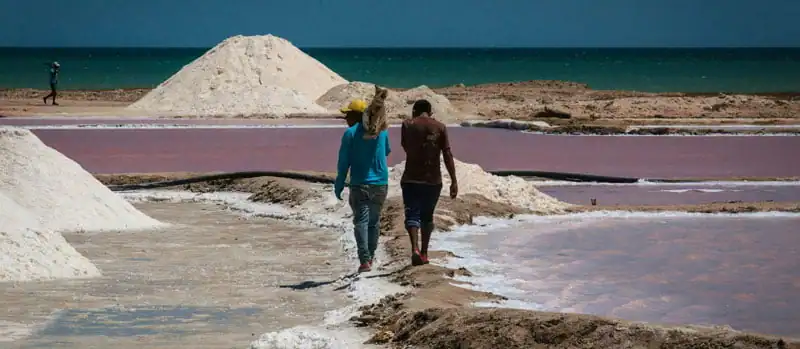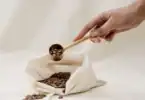Sea salt is a popular ingredient in many kitchens around the world. It is used to add flavor and enhance the taste of various dishes. However, there are different types of sea salt available, and it can be confusing to know which one to use. Two popular options are sea salt and sea salt flakes.
Sea salt is a type of salt that is harvested from the ocean. It is typically unrefined and contains a variety of minerals, including magnesium, calcium, and potassium. This type of salt is available in both coarse and fine textures and is commonly used in cooking and baking.
Sea salt flakes, on the other hand, are a type of sea salt that has been processed in a way that forms into thin, flat flakes. This process gives the salt a unique texture and flavor. Sea salt flakes are often used as a finishing salt, sprinkled on top of dishes just before serving to add a pop of flavor and texture.
Sea Salt vs Sea Salt Flakes
Sea salt and sea salt flakes are both popular types of salt used in cooking and seasoning. While they may seem similar, there are a few key differences between the two.
Sea salt is made by evaporating seawater, leaving behind the salt crystals. It is usually minimally processed and contains trace amounts of minerals like magnesium, calcium, and potassium. Sea salt can come in a variety of textures, from fine to coarse.
Sea salt flakes, on the other hand, are formed by evaporating seawater in a specific way that creates delicate, pyramid-shaped flakes. This process is more time-consuming and labor-intensive than producing regular sea salt, which is why sea salt flakes are often more expensive. For price comparison, here are two Pink Himalayan Salt products, the first one is hard to find finishing flakes, and the second is the much more common coarse pink salt granules.
Much harder to find than the coarse varieties, this is a box of Pink Himalayan Salt prepared as a finishing salt. You get 8.8 ounces (250g).
This one pound package of Pink Himalayan salt is a good 'trial size' to see if you like the flavor and experience of this type of salt. It is a coarse and granular shape - so it's good in a ceramic grinder.
One of the main differences between sea salt and sea salt flakes is their texture and how they dissolve. Sea salt flakes dissolve more quickly and evenly than regular sea salt, making them a good choice for finishing dishes or seasoning foods like popcorn or roasted vegetables. Regular sea salt is better for use in cooking, as it can withstand higher temperatures without losing its flavor.
Another difference is the way they are used in recipes. Sea salt flakes are often sprinkled on top of finished dishes to add a burst of flavor and texture, while regular sea salt is usually added during the cooking process to enhance the flavors of the other ingredients.
Ultimately, the choice between sea salt and sea salt flakes comes down to personal preference and intended use. Both types of salt can add flavor and depth to dishes, and it’s up to the individual to decide which one works best for them.

What is Sea Salt?
Sea salt is a type of salt that is produced by evaporating seawater. It is harvested from saltwater lakes and oceans around the world. The crystals of sea salt are coarser and larger than common table salt, which is produced through mining and refining. The texture, grain size, and particle shape of sea salt can vary depending on the brand and the processing method used.
Sea salt is often preferred by chefs and home cooks over table salt because it has a more complex flavor profile. It contains trace minerals such as potassium, calcium, and magnesium, which can enhance the taste of food. However, the exact mineral content of sea salt can vary depending on the source and processing method.
Sea salt can come in different colors, ranging from white to pink to gray, depending on the minerals present in the seawater. It can also be iodized, which means that iodine has been added to it to prevent iodine deficiency.
What are Sea Salt Flakes?
Sea salt flakes are a type of salt that is harvested from evaporated seawater, where the extraction method produces a thin & expanded crystal structure. Unlike regular sea salt, which is typically more dense, sea salt flakes are formed into delicate, pyramid-shaped crystals that enhance your ability to detect the unique texture and flavor.

Sometimes the flake crystals form interesting flat or pyramid shapes (lower left of image). The flakes tend to be fairly soft, so you can pinch and rub them between your fingers to obtain even smaller bits of salt to evenly spread over your food.
Sea salt flakes are often used by chefs and bakers for their distinct texture and flavor. They can be used to add a finishing touch to dishes, or incorporated into baked goods for a subtle crunch and saltiness. Some popular brands of sea salt flakes include Maldon Salt and Bitterman’s Flake Salt. For more on Maldon Salt, be sure to see the article Maldon Salt: A Reason to Flake Out! To learn about other finishing salts that you might substitute, see Maldon Salt Alternatives.
Sea salt flakes can come in a variety of colors, depending on the minerals and impurities present in the seawater or in the salt pans where the evaporation takes place. The most common sea salt colors tend to be gray or red.
While sea salt flakes are often touted as a healthier alternative to regular table salt, there is little scientific evidence to support this claim. Both types of salt contain sodium, which can contribute to high blood pressure if consumed in excess. To learn more about sodium in your diet, be sure to see Your Diet: How Much Salt is Too Much Salt? to learn more about the health benefits of a balanced amount of salt in your diet.
Despite this, sea salt flakes are often preferred by chefs and home cooks for their unique texture and flavor, as well as their less processed nature compared to regular table salt. They can be used to enhance the flavors of veggies, beans, and spices, and are a staple in many kitchens around the world.
Why Use Sea Salt vs Sea Salt Flakes?
When it comes to using sea salt versus sea salt flakes, the choice ultimately boils down to personal preference and the recipe at hand. However, there are a few key differences between the two that may influence your decision.
Sea salt flakes are larger and flatter than regular sea salt crystals. They add a nice crunch to dishes, making them a great choice for toppings or finishing touches. Sea salt flakes can be sprinkled on top of grilled meats or vegetables or can also be used to add a finishing touch to desserts.
On the other hand, regular sea salt crystals are smaller and more uniform in size. They can be used in a variety of dishes, including soups, stews, and baked goods. Some people simply use sea salt because it can be a bit more affordable, and then to apply it more like a finishing salt, they use a ceramic grinder. For more on this topic, you may want to read Salt Storage: Choosing a Salt Cellar, Salt Grinder, and More.
From a health perspective, both sea salt and sea salt flakes are relatively similar. This is especially true of products that come from the same sea water source (location). Some people prefer to use sea salt because it is less processed than table salt and is less dense.
Overall, the choice between sea salt and sea salt flakes comes down to personal preference and the specific recipe at hand. Both can be used in a variety of dishes and offer unique flavors and textures. Whether you choose sea salt or sea salt flakes, it’s important to use them in moderation and enjoy them as part of a balanced, healthy diet.
Can Sea Salt Flakes Substitute for Sea Salt?
While you can use sea salt or sea salt flakes interchangeably, you may need to adjust the amount needed. Usually, you will want to use less sea salt if the recipe calls for sea salt flakes.
If you’d like to know more exact information about how different salt products vary from a standpoint of sodium content and how to measure the type of salt you’re using, be sure to see Salt Comparison Guide: Salt Sodium Content. In this article we compare the sodium content of a teaspoon of salt for many popular salt types. You’ll be surprised about how much this varies even between the two biggest brands of Kosher salt!
Sea salt flakes are larger and have a more delicate texture than regular sea salt. They are often used as a finishing salt, sprinkled on top of dishes to add a pop of flavor and texture. Regular sea salt, on the other hand, is used for cooking and baking, and can be added to dishes during the cooking process. For an in depth examination of finishing salts, most of which are flake products, you might be interested in reading Maldon Salt Alternatives where we compare one of the premium sea salt flakes, Maldon salt, to other naturally harvested sea salts.
If a recipe calls for sea salt flakes and you only have regular sea salt, you can still use it as a substitute. However, you may need to adjust the amount of salt used and when it is added to the dish. For example, if a recipe calls for 1 teaspoon of sea salt flakes to be sprinkled on top of a dish, you may need to use slightly less regular sea salt and add it during the cooking process instead of as a finishing touch.
Similarly, if a recipe calls for regular sea salt and you only have sea salt flakes, you can still use them as a substitute. However, you may need to crush the flakes into smaller pieces before adding them to the dish to ensure that they distribute evenly.

Frequently Asked Questions
Are Sea Salt Flakes Healthier than Regular Sea Salt?
While sea salt flakes may have a slightly different mineral content than regular sea salt, the difference is minimal. Both types of salt are primarily made up of sodium chloride. Therefore, there is no significant difference in terms of health benefits between the two, especially when the salt comes from the same saltwater source. Sea salts from different places may vary a bit more in mineral content, but the impact on health would be minimal.
Do Sea Salt Flakes Dissolve Differently than Regular Salt?
Yes, sea salt flakes dissolve differently than regular salt. Because of their unique shape and texture, sea salt flakes may dissolve more slowly than regular salt on surfaces. This is mostly because the expanded shape and texture allows the salt flakes to sit above the moisture in the food.
If you pour the salt into water – such as when salting pasta water, there should not be a noticeable difference.
Are Sea Salt Flakes More Expensive than Regular Sea Salt?
Generally, sea salt flakes are generally more expensive than regular sea salt. This is because the process of drying the salt in flakes is more labor-intensive and time-consuming than simply harvesting the salt. Above in this article, we compared sea salt and sea salt flakes made from Pink Himalayan salt. Sea Salt Flakes are also more expensive when comparing more commonly available white salts. In the comparison below, the flakes and the coarse sea salt come from the same company, so you can get a accurate picture of the difference in cost between the two forms.
Comparing the price of sea salt vs sea salt flakes from the same brand/production location:
These flakey bits of salt are designed as a finishing salt. You get a 7 ounce package.
This sea salt is sold in a 14 ounce bag. The salt has a nicely uniform coarse size and shape.
Final Thoughts
After considering the differences between sea salt and sea salt flakes, it is clear that both have their own unique characteristics and uses.
Sea salt is a versatile ingredient that can be used in a variety of dishes, from savory to sweet. It is available in different textures and sizes, making it easy to find the right type for any recipe.
On the other hand, sea salt flakes are ideal for finishing dishes and adding a touch of texture and flavor. They are delicate and dissolve quickly, making them perfect for sprinkling on top of salads, roasted vegetables, or grilled meats.
Ultimately, the choice between sea salt and sea salt flakes depends on personal preference and the specific dish being prepared. Both are great options that can enhance the flavor of any recipe.
Table of Contents
Vietnamese salt production photo by Quang Nguyen Vinh. Salt evaporation pans in Colombia photo by Nicolás Torres Fernández.
Looking for other Sea Salt taste sensations? Check out the article on From Sea To Smoker: Your Guide To Homemade Smoked Salt.











